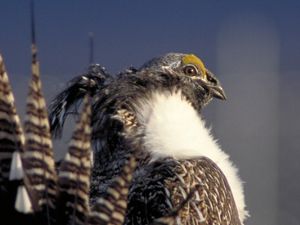- Phone: 406-443-0303
-
Follow
Protecting high-elevation sagebrush habitat for a working wilderness.
A Unique Landscape
Among the High Divide Headwaters lies vast sagebrush habitat, unique and distinct from others in the Great Basin and Montana’s Great Plains due to its altitude. These high-elevation sagebrush grasslands support a wetter mosaic of habitats, many of which are essential for species that are declining across their broader range, like the greater sage-grouse.
Approximately 90 bird species and more than 85 mammals have come to rely on these high-elevation sagebrush grasslands for habitat, which, when healthy, are more resistant to invasive plants, have a higher percentage of cover to hide from predators and produce more seasonal forage. In the future, we can look to these landscapes to serve as a refuge in a warmer and drier climate.
Yet, wildlife are not the only ones that call the Sagebrush Steppe home. Ranchers also rely on the remote and wild grasslands for livestock grazing, making this critical habitat a delicate but dynamic working wilderness.
Threats to Sagebrush Habitat
The sagebrush grasslands, though resilient, become ever more fragile when pressured by human activity. Scientists have long suspected that cattle grazing was one of the primary contributors to the degradation of sagebrush habitat. However, the results of a 2016 study show that “current grazing practices in the Centennial Valley appear to have minimal effects on sage-grouse reproduction and survival during nesting and brood rearing seasons.” That is to say, the typical good stewardship demonstrated by livestock grazers in these high-elevation pastures, such as not grazing in areas when sage-grouse are nesting, has long supported a place where ranchers and wildlife can live in harmony. This is one of the reasons why greater sage-grouse populations are stable in the High Divide while rapidly declining elsewhere.
Rather, the primary threats to Southwest Montana’s sagebrush grasslands include habitat fragmentation caused by residential development and exurban expansion. Invasive plants, conifer encroachment and barriers such as fences are also responsible for the loss of these otherwise intact and resilient intermountain sagebrush seas.
Opportunities: Greater Sage-Grouse
The recent success of greater sage-grouse conservation is a testament to how The Nature Conservancy (TNC) has brought private and public land managers together to achieve lasting conservation outcomes. In 2010 the U.S. Fish & Wildlife Service declared the greater sage-grouse as a candidate species for future listing under the Endangered Species Act, an action that granted private and public land managers and wildlife managers five years to put all promising conservation tools to work in order to halt the range-wide decline of the bird. In September 2015, the service determined that protection for the greater sage-grouse under the Endangered Species Act was no longer warranted. This outcome and future protection depend heavily on conservation opportunities such as:
- Protection
- The NRCS-ALE and Montana State Sage-Grouse Habitat Conservation Program provide funding to encourage more conservation easements.
- Stewardship
- The Nature Conservancy is a founding member of the Southwest Montana Sagebrush Partnership (SMSP). This coalition of state and federal agencies, local conservation districts and The Nature Conservancy are restoring and enhancing habitat and working with private ranches to enhance their operations in ways that help both nature and the owner’s bottom line. SMSP can work across boundaries and leverage funding opportunities to conserve sagebrush grasslands at a scale that matters.
- Projects include removing encroaching trees conifers—pine, juniper and Douglas-fir—that diminish sagebrush habitat, building low-tech structures that slow and retain water, reducing erosion and fortifying wet meadows, and modifying fences to make them more wildlife friendly.
- Science
- Researchers from Montana State University, in partnership with TNC and the Red Rock Lakes National Wildlife Refuge, spent three years in the Centennial Valley gathering data on greater sage-grouse populations, nesting and brood-rearing habits, and winter migration patterns. The preliminary results of this project are helping us to understand the impacts of grazing infrastructure such as water tanks, fences and roads, as well as to measure the importance of winter habitat availability for sage-grouse success.
What Is TNC Doing Next?
Through easements and purchasing these lands, The Nature Conservancy in Montana is able to protect this diverse habitat from threats of development. Yet this alone is not enough to preserve this landscape and ensure it can remain a working wilderness for both ranchers and nature. That’s why we provide resources to help landowners improve their management practices and restore degraded habitat.
TNC also works to refine our understanding of maintaining and restoring sagebrush grassland systems through science—especially as it relates to climate change and wide-ranging mammals. TNC science and stewardship staff are working with spatial analysts to measure the widespread impacts of conifer encroachment throughout the High Divide.
Help Protect Sagebrush Grasslands
Support our work in Montana, including conservation science and the preservation of sagebrush ecosystems, by making a charitable contribution today.
More Sagebrush Stories

The Sagebrush Sea Is Vanishing
The sagebrush sea, 150 million acres of complex grasses, shrubs and rare species, has dwindled to half its historical range. To protect what remains, TNC has launched the Sagebrush Sea Program.

Sage Grouse
At one time the bird picked its way through sagebrush in 13 states and three Canadian provinces and numbered as many as 16 million. Today approximately 200,000 birds remain.

Reclaiming the Sage
In an effort to restore sagebrush on old mine sites in Wyoming, TNC scientists have taken to the lab—one that looks a bit like a hybrid kitchen and plant nursery.
